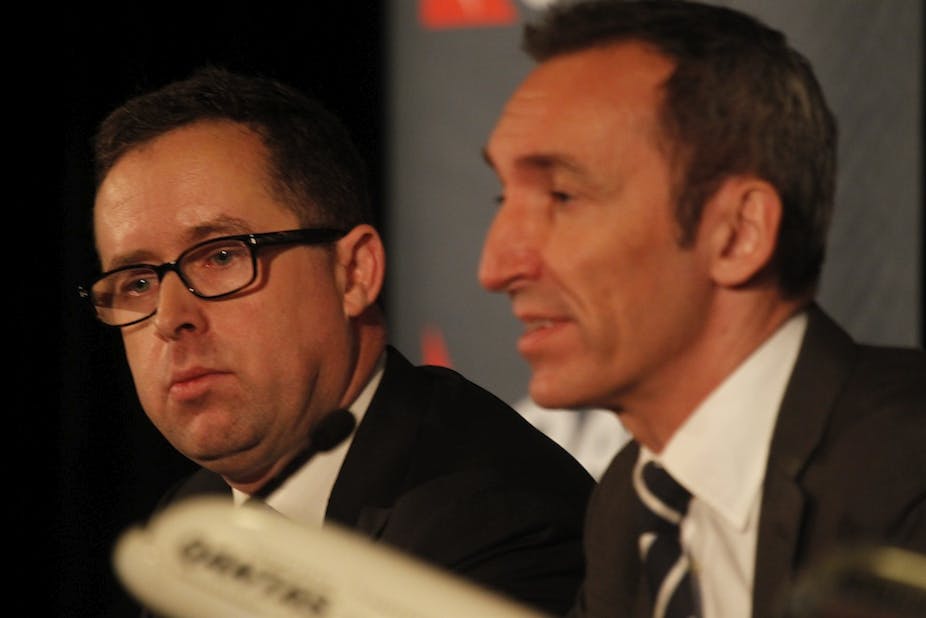Virgin Australia has joined arch rival Qantas in delivering a multi-million dollar half-year loss - albeit on a smaller scale.
Both airlines have swung from profit to loss - Virgin from a prior half-year profit of A$23 million to a loss of $49.7 million, and Qantas from a half year profit of $148 million to a loss of $305 million.
Qantas reported net free cash flow outflows of $358 million, and this was largely responsible for the reduction on cash balances. Virgin reported a net free cash outflow of $218 million.
This situation is clearly not sustainable for either airline and Qantas has already announced a series of initiatives with the goal of removing $2 billion in costs by 2017.
The productivity challenge
Qantas has identified productivity and consolidation improvements as delivering $1.05 billion worth of cost savings, and a major contributor to this will be the restructuring of operations and a reduction of 5,000 jobs. This is endeavouring to address staff costs which is perhaps the most persistent problem.
Staff expenses continue to be high and accounted for 24% of total revenues in the last half year, and while Qantas claims to have achieved a 22% improvement in labour efficiency since 2008, this is likely overstating the gains. This gain is calculated on the basis of staff members per passenger, whereas most productivity measures are based on available seat kilometres (ASK). This difference is significant as passenger numbers grew by 25% over this period, while ASK grew by only 10%. This creates the illusion of much greater gains.

The challenge for Qantas management will be to ensure that real productivity increases materially. Another way of thinking of this dilemma is that employee expenses as a percentage of total revenues have changed little for Qantas over the last decade at around a quarter of total revenues. In comparison, the ratio is 15% for Singapore Airlines. Put simply, the announced job losses are a step in the right direction, but they are unlikely to reduce the gap by half, and this is inevitably just the beginning.
Getting the fleet right
Other cost cutting initiatives planned by Qantas include “right sizing” the fleet which will deliver savings of $600 million. Practically it means the early retirement of ageing and relatively fuel inefficient 747, 767 and 737-400 aircraft. While this will reduce fuel expense which is important, it will also streamline aircraft operations and a manifestation of this is the recently announced closure of the 747 heavy maintenance facility.
A fleet of seven aircraft types is cheaper to maintain and operate than a fleet of 11 aircraft types. But does this go far enough? It is notable that Ryanair, possibly the lowest cost airline in the world, operates a fleet of 303 aircraft of only one type - 737-800’s. While this comparison is not strictly appropriate, it does demonstrate the principle that minimising aircraft types is important for minimising costs.
Qantas has also announced the deferral of aircraft acquisitions. Doubtless the downgraded credit rating factored into this decision as major acquisitions would need to be debt financed, and this would have become increasingly expensive.
Asset crunch
However, these acquisitions are necessary to maintain a cost efficient fleet, and notwithstanding the limited aircraft purchases in the current period there still was a net free cash outflow of $358 million. While this can for a short time be financed from cash reserves, new borrowings will be necessary in the longer term. Hence the intense lobbying for a government guarantee.
Doubtless parallels will be drawn to the government guarantee for bank debt during the GFC. But there are fundamental differences. During the GFC the problem for the banks was more one of liquidity rather than value. For Qantas the issue is value, and this is the dilemma for government.
Virgin has followed suit today and said its business efficiency project was on track to deliver more than $400 million in productivity gains by the middle of next year and return the airline to profitability. Reflecting on potential government support for Qantas, which could be in the form of a debt guarantee, Virgin Australia chief executive officer John Borghetti today said “Any government or opposition should think very carefully before it decides to pick winners in any industry”.
Value is also at the heart of another issue for Qantas – asset impairment.
There is a basic principle in accounting that the book value of assets should not exceed the fair value of the assets, and if this occurs assets should be written down or impaired. A market to book value of less than one is an indicator of asset impairment, and Qantas has been in this position for many years. This would necessitate impairment testing of assets in accordance with accounting regulations, but problematically there is little (no) information disclosed by Qantas on how this is satisfied.
With poor operating profitability and a weak market for used aircraft more information would be useful. The concern is that the market is sending a clear signal it does not see the value in the assets that Qantas management does. This is an issue not just for Qantas, but also for auditors and regulators to determine if the regulation is being complied with, or whether the disclosures required by the regulation are sufficient.
The only certainty from these announcements is that the cost-cutting strategy announced by Alan Joyce yesterday is just the beginning of a long and painful journey for Qantas and all its stakeholders.

